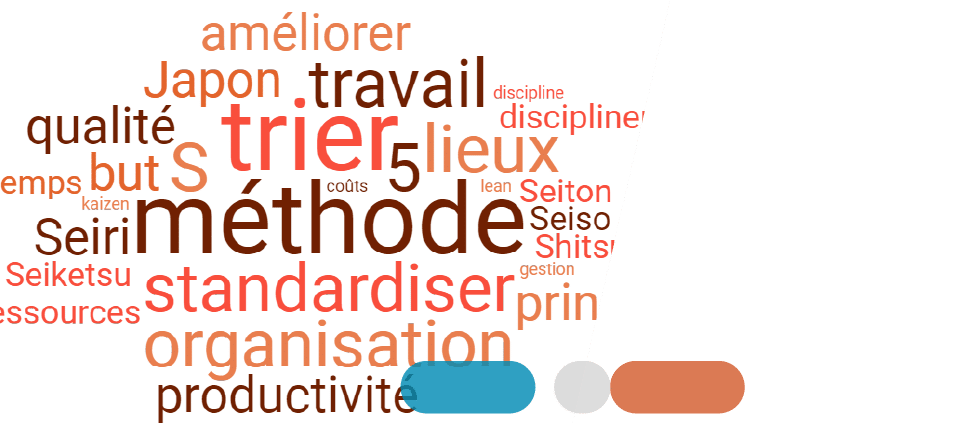You’ve heard of the 5S method, but don’t know exactly what it involves? It’s considered a very important tool for improving the performance and development of organizations.
In this article, we explain how the 5S method is defined and how it works, as well as its advantages and benefits, particularly in terms of improving productivity, optimizing safety and reducing waste. Here’s how it works.
What is the 5S method ?
Are you looking for more information on the 5S method ? Would you like to know more about its principles and benefits ? In what follows, we’ll explain what the 5S method is and how it works. We’ll also give you an overview of the benefits it brings.
Definition of the 5S method
The 5S method is a workplace organization method developed in Japan. Its aim is to improve the quality, productivity and well-being of employees.
It is based on the following five principles:
-
-
- Seiri (sort).
- Seiton (organize).
- Seiso (clean).
- Seiketsu (standardize).
- Shitsuke (discipline).
-
These principles are applied together to achieve their objectives.

Don’t have time to read the whole article? Download it and read it at your leisure.
Advantages and applications of the 5S method :
The 5S method promotes the efficient use of resources and rapid, effective decision-making. It is used in sectors such as industry, commerce and services.
Among other things, it helps to :
-
-
- • Improve the working environment.
- • Saves time searching for tools and materials.
- • Reduce waste and costs.
- • Identify and solve problems.
- • Increased performance and quality.
-
In this way, the 5S method has a positive impact on the productivity and quality of services and products. It is often used in conjunction with other continuous improvement methods such as Lean Manufacturing or Kaizen.
History and origins of the 5S method
You may be wondering how the 5S method came into being. To answer this question, the 5S method was created in Japan over 60 years ago.
That was when Toyota Motor Corporation was looking to implement an operations management system. The aim was to provide an organized workspace conducive to employee productivity.
Subsequently, the 5S method has been adopted by many companies around the world, and its aim is to reduce waste and improve product quality and customer satisfaction.
How does the 5S method work ?
This Japanese method is divided into five stages. This system is mainly used in the industrial field, and has a precise objective : to improve efficiency and optimize work.
First stage of the 5S method : Seiri (sorting)
The first Seiri step involves sorting and eliminating unnecessary objects or tools.
Second stage of the 5S method : Seiton (organize).
Next comes Seiton, which is the organization of remaining tools and information. The aim is to arrange them in an optimal, logical way for easy access by teams.
Third stage of the 5S method : Seiso (clean up).
Next, Seiso is the cleaning and maintenance of tools and documents. The aim is to keep them in good condition for optimum durability and use.
Fourth step in the 5S method : Seiketsu (standardize).
Seiketsu refers to the standardization of processes. The aim is to put in place standardized procedures to facilitate work and the exchange of information between teams.
Fifth stage of the 5S method : Shitsuke (discipline).
The last stage, Shitsuke, is about discipline. It involves maintaining the principles and procedures put in place to ensure that processes run smoothly.
Advantages and benefits of the 5S method
Would you like to find out more about the benefits of the 5S method? Below you’ll find additional information and different points of view on the subject. We’ll give you a different perspective on the advantages and benefits of the 5S method.
Improving productivity
Improved productivity is one of the main benefits of the 5S method, and this manifests itself through a number of advantages.
- • Reduced search time : by optimizing the storage and classification of objects and tools, and making it easier to identify and use them.
- • Improved quality of finished products : through better use of resources and greater precision in manufacturing and production processes.
- • Increased employee concentration and productivity : by providing a more organized and efficient working environment.
Optimized safety
One of the main benefits of the 5S method is its impact on safety. By optimizing the use of workspaces, the company can reduce the number of accidents and improve risk prevention.
Employees can work in a safe environment. This generates greater trust and respect among employees, which in turn can help improve overall performance and productivity.
What’s more, thanks to the 5S method, companies can reduce their health and safety costs, which can also benefit their finances.
Reduced waste
Using the 5S method can significantly reduce waste and improve process efficiency.
Indeed, the principle of the 5S method is to eliminate everything that is superfluous and keep only what is necessary for the process.
It also reduces energy consumption, while ensuring the quality of the finished product.
Implementing the 5S method is very simple and can be adapted to any situation. It offers many short- and long-term benefits in terms of reduced energy consumption and product quality… Don’t hesitate to apply its principles to improve your processes and productivity..
FAQ
What is the 5S method?
The 5S method is a continuous improvement methodology designed to optimize the functioning of companies and organizations. It is based on five principles: Seiri (sorting), Seiton (tidying), Seiso (cleaning), Seiketsu (standardization) and Shitsuke (discipline).
How does the 5S method work ?
The five principles of the 5S method are applied successively to improve the efficiency and productivity of company processes. The first step consists in sorting out unnecessary objects, documents and tools to save space and time. The second step is to organize existing objects, documents and tools to optimize their accessibility. The third step is to clean surfaces and equipment to improve hygiene and health in the workplace. The fourth step is to standardize processes to ensure optimal, sustainable operation. Finally, the fifth step is to establish discipline in compliance with established rules.
What are the benefits of the 5S method ?
The 5S method enables companies and organizations to significantly improve their efficiency and productivity, thanks to better organization of the various tools, documents and objects needed to keep the business running smoothly. It also improves health and hygiene in the workplace, and optimizes processes for optimal, sustainable operation.
Where does the 5S method come from ?
The 5S method was developed in Japan in the 1950s by Toyota Motor Corporation to improve the efficiency and productivity of its factories. Since then, it has been adopted by companies around the world.
How to implement the 5S method ?
To implement the 5S method, it is necessary to train staff in this methodology so that everyone understands how it works and its potential benefits. Once all employees are familiar with the principles of implementation, they must commit to rigorously following the procedures defined by each stage of the process.






